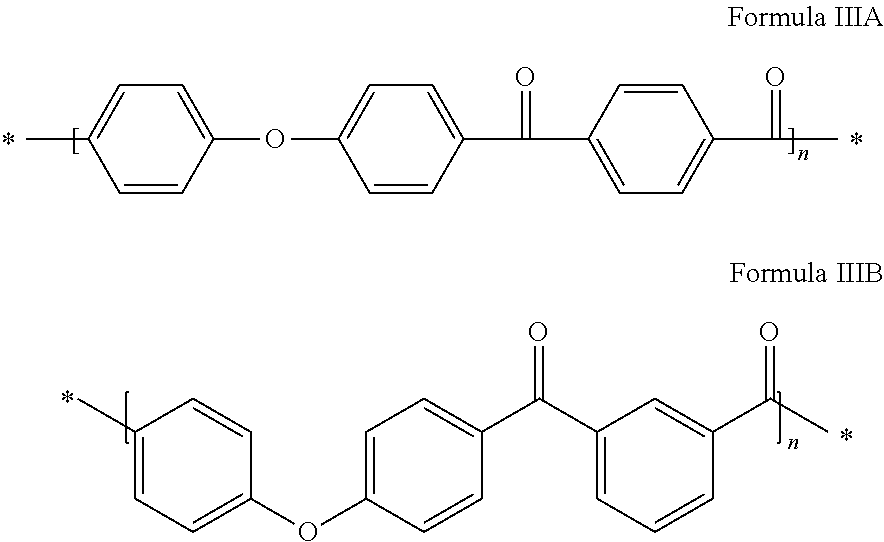Method for synthesizing polyaryletherketones
a technology of polyaryl ether and ether, which is applied in the direction of additive manufacturing processes, additive manufacturing with solids, etc., can solve the problems of difficult nucleophilic substitution process, difficult synthetic conditions, and difficult access to monomers
- Summary
- Abstract
- Description
- Claims
- Application Information
AI Technical Summary
Benefits of technology
Problems solved by technology
Method used
Image
Examples
example 1
[0053]The content of residual organic solvent is evaluated by gas chromatography according to the following protocol:
[0054]Sample Preparation Protocols
[0055]Extraction with dichloromethane by sonication for 20 minutes:[0056]Sw=20 mg-50 mg of sample[0057]0.9 ml dichloromethane[0058]0.1 ml of internal standard (pentadecane) dissolved in dichloromethane.
[0059]GC operating conditions: Varian 3800 with CP8400 autosampler[0060]Column: BPX35 L=32 m; ID=0.25 mm; Film=1 μm[0061]Flow rate (constant mode)=1.3 ml / min[0062]FID detector temperature: 300° C.[0063]Injector temperature 1177: 250° C.[0064]Split ratio=25[0065]Oven temperature program: 40° C. (2 min)→280° C. (2 min) at 8° C. / min[0066]Injection mode: autosampler[0067]Injection volume=1 μl[0068]Carrier gas: helium
example 2
[0069]Protocol for measuring the residual aromatic ethers:
[0070]The samples are dissolved in a BTF / HFIP mixture in the presence of an internal standard.
[0071]All the analyses were performed on a Varian® 3800 GC machine equipped with a 1041 on-column injector and an FID detector.[0072]Column: MXT 500 Sim Dist 6 m / 320 μm / ef=0.15 μm[0073]Det. temperature (FID)=400° C.[0074]1041 injector temperature=set at T≦40° C.[0075]Column flow rate (constant flow)=3 ml / min[0076]Oven program=40° C. (2 min)→150° C. at 8° C. / min[0077]150° C. (0 min)→330° C. (0 min) at 15° C. / min[0078]330° C. (0 min)→360° C. (5 min) at 25° C. / min[0079]Carrier gas=helium[0080]Injection mode: into the column with the injection point located in the part regulated by the oven.[0081]Volume injected=0.5 μl
example 3
Comparative Example
Treatment with MeOH
[0082]Ortho-dichlorobenzene (1600 g) and EKKE (65 g) are placed in a 2 L reactor equipped with a stirrer, under a stream of dry nitrogen. The acid chlorides are then added: terephthaloyl chloride (5.4 g), isophthaloyl chloride (22.2 g) and benzoyl chloride (0.38 g). The reactor is then cooled to −5° C. AlCl3 (115 g) is then added while keeping the temperature in the reactor below 5° C. After a homogenization period (about 10 minutes), the reactor temperature is raised by 5° C. per minute up to 90° C. The polymerization starts during this temperature increase. The reactor is maintained for 30 minutes at 90° C. and then cooled to 30° C. 400 g of methanol are then added slowly so as not to exceed a temperature of 60° C. in the reactor. The reactor is stirred for 2 hours and then cooled to 30° C.
[0083]The reaction medium is then removed from the reactor and a first filtration is performed on a sinter, in which part of the solvent is thus removed fro...
PUM
| Property | Measurement | Unit |
|---|---|---|
| temperature | aaaaa | aaaaa |
| temperature | aaaaa | aaaaa |
| temperature | aaaaa | aaaaa |
Abstract
Description
Claims
Application Information
 Login to View More
Login to View More - R&D
- Intellectual Property
- Life Sciences
- Materials
- Tech Scout
- Unparalleled Data Quality
- Higher Quality Content
- 60% Fewer Hallucinations
Browse by: Latest US Patents, China's latest patents, Technical Efficacy Thesaurus, Application Domain, Technology Topic, Popular Technical Reports.
© 2025 PatSnap. All rights reserved.Legal|Privacy policy|Modern Slavery Act Transparency Statement|Sitemap|About US| Contact US: help@patsnap.com



